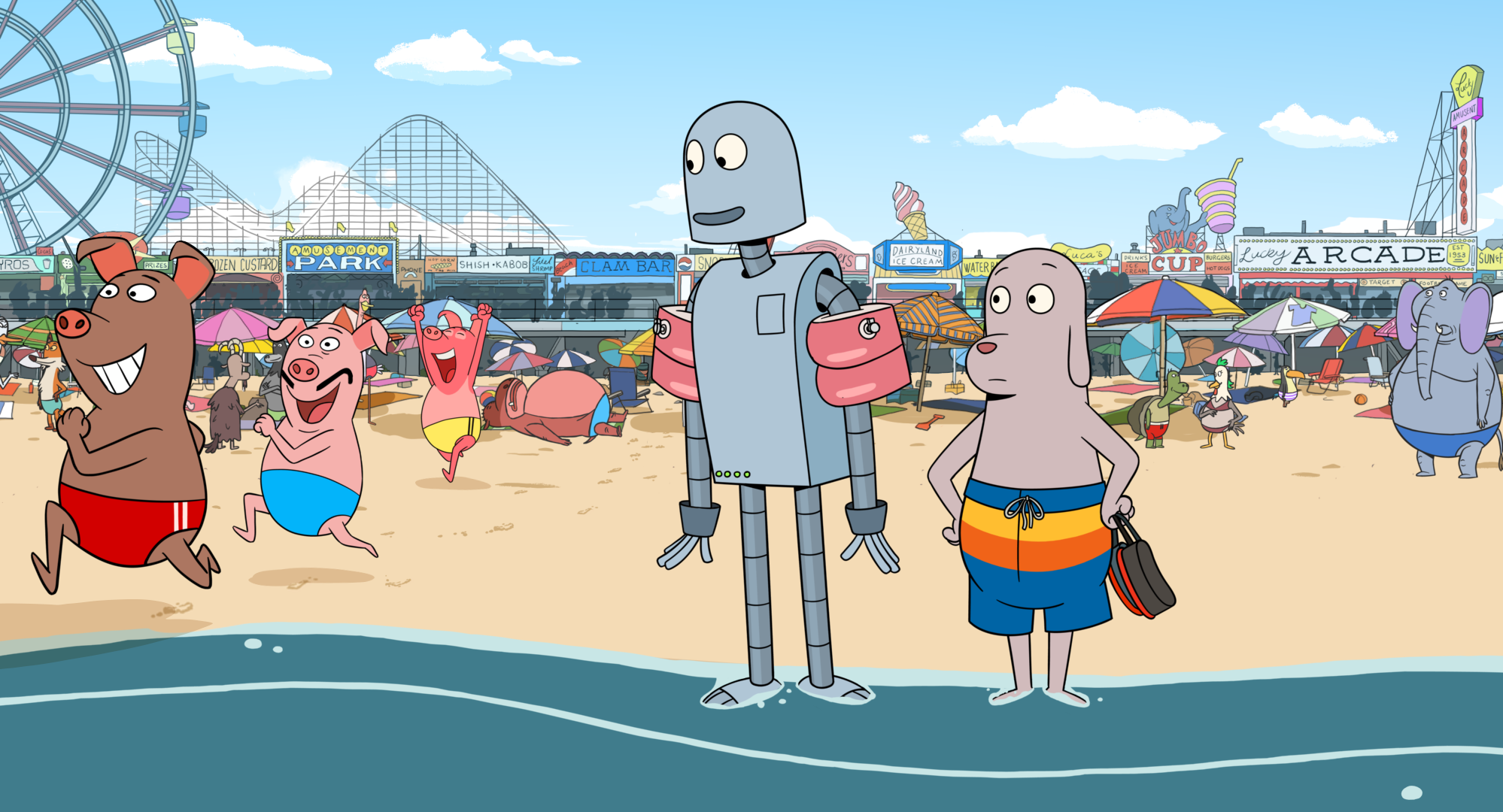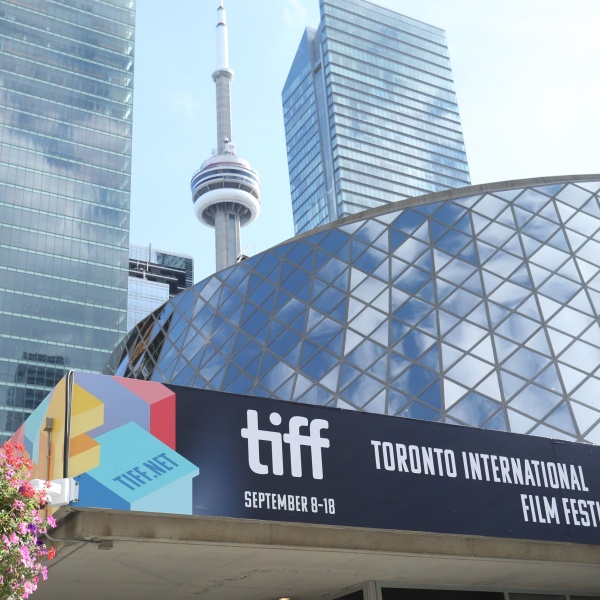
The miracle of friendship rather than the image of electric sheep is what occupies the subconscious of the charming android gleefully strolling through “Robot Dreams,” Spanish director Pablo Berger’s first animated venture. Fashioned into moving form from the graphic novel by Sara Varon, this hand-drawn buddy dramedy preserves both the cartoon strip aesthetic and lack of dialogue of the source material for a delightfully bittersweet animated wonder that embodies the medium’s most purely cinematic qualities. Now the fierce battle for the title of the best animated film of the year has a new strong contender.
More akin to the sophisticated world of “BoJack Horseman” than that of Disney’s “Zootopia,” the setting is 1980s New York City — the twin towers of the World Trade Center still frame the skyline — but densely populated with an array of anthropomorphic animals. The bustling energy of the Big Apple shines through in how its residents go about their business in the background of the main plot. The metropolis holds a million stories, some of which we occasionally get a glimpse into via the film’s abundant and amusing sight gags.
Crowded and incessantly in flux as it is, the urban center represents a prime territory for its inhabitants to experience emotional isolation even if one would struggle to find total physical solitude. Plagued with such loneliness one night in his East Village apartment, Dog, a pudgy bipedal canine, buys a robotic companion from a late-night infomercial with the same ease as he would a kitchen appliance. After some required assembly, Robot, a lanky and yet impressively flexible automaton with a beaming grin and kind eyes, comes alive to fend off the gloom in Dog’s existence. The dog days are indeed over, or so he thinks.
With contagious joie de vivre, the two instant bros take on Manhattan, rollerblading in Central Park to the tune of Earth, Wind & Fire’s groovy “September,” whose lyrics about reminiscing on the glory of bygone days will later gain resonance, or simply basking in the quiet pleasures of having someone to share the mundane marvels of everyday life. No one has enjoyed these streets more than this pair. Together, every instant brims with freshness.
“Robot Dreams” calls to mind the grounded fantastical warmth of films such as “Robot and Frank” or last year’s “Brian and Charles,” which don’t get caught up in the mechanics, ethical implications, or perils of artificial intelligence in the sobering manner that say Spielberg’s “A.I.,” “Ex-Machina” or the recent horror hit “M3GAN” do; and instead focus on the heartfelt nature of their central relationships. Tonally, its closest relative in this ever-growing family of on-screen fraternal ties between flesh-and-bone individuals and sentient metal humanoids is Brad Bird’s animated masterpiece “The Iron Giant.” Berger’s much lower-stakes balm of a movie, however, stands out for its own non-verbal ingenuity.
The muscular simplicity of the sharp line work and the playful character design in “Robot Dreams” mimics the ligne claire graphic style first popularized in the first half of the 20th century by Belgian cartoonist Hergé, best known for creating “The Adventures of Tintin.” Faithful to Varon’s work, Berger’s animated effort preserves the vivid solid colors without much shading and the visual business of the intricate production design, which captures the sensory overload of the city and earns it a spot among the great New York movies.
Within this loving tribute to the frantic charm of NYC, the director inserts inconspicuous nods to his homeland: Dog carries a bag emblazoned with a humanlike orange named Naranjito, the mascot for the 1982 World Cup held in Spain, and later receives a devastating postcard from Barcelona. Considering Berger’s exquisite “Blancanieves,” a black-and-white adaptation of “Snow White” into a Spanish context during the country’s civil war, which boasted bull fighters and flamenco dancing, it’s no surprise then that his whimsical sensibilities would eventually hurtle him into the boundless arms of animation.
But perhaps what made the Spanish storyteller an ideal interpreter for Varon’s tender American bromance is that his “Blancanieves” also featured no spoken dialogue. He relied mostly on the facial expressions of his protagonists and the information rendered visible within the frames. In “Robot Dreams,” Berger’s knack for irreverent humor is laced with the influence of the silent era masters of physical comedy, namely Charlie Chaplin and Buster Keaton, with the notable difference that a rich soundscape enlivens the environment.
At the height of Dog and Robot’s flourishing camaraderie, a fortuitous beach day of underwater adventures and unforgettable fun throws a wrench into their plans for a future side by side. Stranded on the sand without movement, innocent Robot dreams up positive hypothetical scenarios hopeful that Dog will find a solution to their forced separation.
Whatever version of events he imagines always leads to a long-awaited and magical reunion with Dog. Meanwhile, the other half of this partnership fights bureaucracy to regain access to the shore. Dog’s growing impotence and the inevitable passage of time slowly erode what once seemed unbreakable, not out of disinterest but mere distance between them.
Robot’s eponymous dreams communicate his utterly sincere longing for platonic companionship, the only love he’s ever known, at times as darkly droll vignettes. One particularly radiant sequence that unfolds in his wired subconscious borrows elements from the “The Wizard of Oz” and its promise of a wish granted and repurposes them into a psychedelic fever vision. Each passage elucidates fears and yearnings with potent clarity. That Berger and his animation team programmed into his character and the narrative as a whole such astoundingly profound ruminations, delivered as part of this brightly colored metropolitan fable, denotes the affecting effectiveness of their pitch-perfect artistry.
Both Robot and Dog ultimately move on from the intensity of their bond, not exactly by choice but out of spiritual necessity. Robot quite literally sings a different tune and changes his appearance after making a new caring friend. But the fault for the schism doesn’t fall on either of them. That lack of a villain in many of the painful transitions we experience in our time alive is what “Robot Dreams” gets at beautifully. When the voices of Earth, Wind & Fire once again asks them, “Do you remember?” the answer is most certainly affirmative, but one of them chooses a sacrificial act of love: to spare everyone the hurt and awkwardness of an untimely reconnection. Their timelines have been unaligned, and maybe that’s how they are meant to stay. With its soulful tin heart, “Robot Dreams” moves us to appreciate the fortune of having a precious pal. Whether for a season or a lifetime.
Grade: A
“Robot Dreams” premiered at the 2023 Cannes Film Festival. It has been acquired by Neon for North American distribution.



